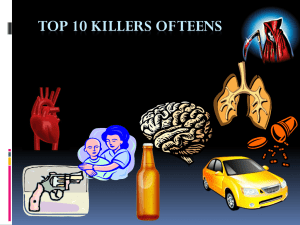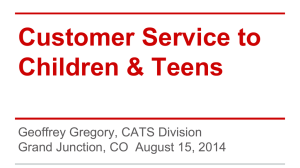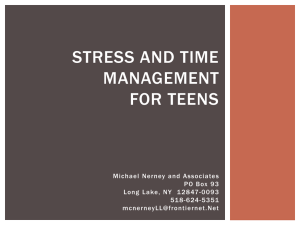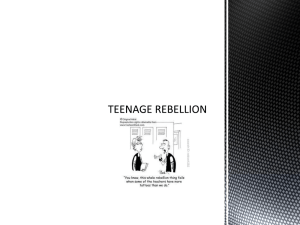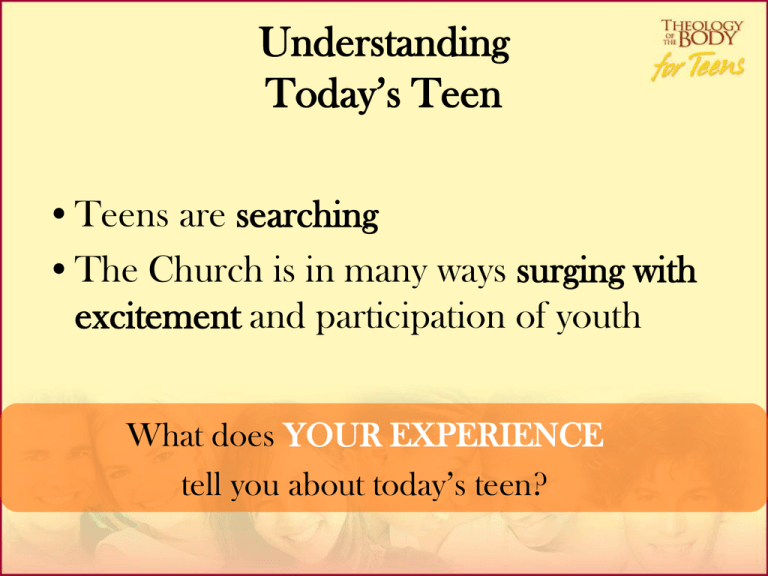
Understanding
Today’s Teen
•Teens are searching
•The Church is in many ways surging with
excitement and participation of youth
What does YOUR EXPERIENCE
tell you about today’s teen?
The Gen Y/Millenial
--Are part of the “Me”
Millennials by Sara Berman)
Generation (The Narcissistic
--Their most important goals:
To be rich
- 81%
To be famous
- 51%
To help people in need
- 30%
To be community leaders - 22%
To become more spiritual - 10%
The Gen Y/Millenial
•First cell phone generation; dealing with
Internet consequences;
•Over-stimulated; busy and distracted; identity
marketed to them;
•Marked by evil of 9/11 & terrorism; Iraq War
and major natural disasters like…
•The Indian Ocean Tsunami and Hurricane
Katrina;
•“Reality” taught to them through TV
The Gen Y/Millenial is:
• Rat race like their parents; think they are more
mature than they are, thus they drink, smoke, party,
etc.
• LOST: materialistic; longing for purpose; extreme;
often hopeless and depressed
• FOUND: spiritually beginning to balance emotion
& substance;
• A very “bodily” generation -- tattoos, piercings,
surgically altered, oversexed, underdressed, etc…
• Primed and ready for the Theology of the Body
• Princess Bride: Pre-conceived notions
Introduction to
John Paul II
• Witnessed the smearing of the dignity of the
human person: Nazism, the holocaust,
communism, totalitarianism, economic
utilitarianism, etc.
• He not only saw this – he experienced it
• Need for Gospel relevancy in the modern world
• Male/female relationship:
– “substratum of all ethics and culture”
• Regain an “adequate anthropology” to reconnect
men and women with our dignity and original
purpose
Introduction to
John Paul II
• Connect to the “echo” of original experiences
• As well as each human heart and in our own
experience
• “Subjective turn” of modern philosophy – but
points to Christ
• Our teens face similar threats in different
masks: abortion holocaust, 9/11, Virginia Tech,
terrorism, false freedom of relativism,
“religious” violence, sexual utilitarianism, etc.
What is the
Theology of the Body?
• Pope John Paul II -- 129 short talks between
September 1979 and November 1984 (135 total)
• Building a “theological anthropology”
– Who am I? (adequate anthropology)
– How am I to live? (ethics & vocation)
• Nature of the human person—embodiment,
distinction, and dignity of men and women
What is the
Theology of the Body?
• Theology (study of God)
• of the Body (as revealed through the body)
• The body entered theology through the “main
door” when the Word became flesh
• Philosophical, theological, and moral
consequences
Called to Love & Communion
• “The fundamental and innate vocation of
every human being is love” (FC, 11)
• Today, “love” is confusing but JPII points
us to Christ, the “main door” through
which the body entered theology
• Christ points us back to the beginning – “in
the beginning it was not so” (Mt. 19:8)
– “Echo” of Original Experiences
Love is Relevant
•"Man cannot live without love. He remains a
being that is incomprehensible to himself, his
life is senseless, if love is not revealed to him, if
he does not experience it and make it his own, if
he does not participate intimately in it"
(Redemptor hominis, 10).
•“He who does not love does not know God, for
God is love” (1 Jn 4:8)
•Love is man’s origin, his journey, his destination
Theology of the Body: Part 1
Establishing
“Adequate
Anthropology”
Original Man
Man’s Original
Experiences
Historical Man
Man’s History
Christ at Center
Eschatological Man
Man’s Destiny
Union w/ God
Theology of the Body: Part 2
Applying
Adequate
Anthropology to:
Ethics & Vocation
Celibacy for
the Kingdom
Sacramentality
of Marriage
Love &
Fruitfulness
TOB = Total Vision for Love & Life
1. Original Man
Our origin in communion of love
2. Historical Man
Fallen, yet redeemed in Christ
3. Eschatological Man
Our Union is Complete in Heaven
4. Celibacy for the Kingdom
Embracing Heavenly Marriage while Still On Earth
5. Sacramentality of Marriage
In Covenant of Love, The Two Become One Flesh
6. Love and Fruitfulness
Love Bears Fruit, Responsible Parenthood
TOB for Teens
Breakdown
Who am I?
(Adequate Anthropology)
1. Created for Love
2. Love Defined
3. Naked Without Shame
4. Hope & Redemption in Christ
TOB for Teens
Breakdown
Building the Bridge
(From Anthropology to Living it Out)
5. Truth & Freedom
How am I to live?
(Ethics & Vocation)
6. Language of the Body
7. Free, Total, Faithful, Fruitful
8. Marriage
9. Celibacy & Religious Life
TOB for Teens
Breakdown
Practical Application
(Training in Faithfulness Now)
10. Finding Your Vocation
11. Dating with Purpose & Purity
12. Living the Good Life
How does the TOB
connect with teens?
• We all need love and search for it; teens search as
hard as anyone
• They become frustrated, disillusioned and
confused about the meaning of life
• Most teens know they were not created “to be
alone” but they so desperately want communion
that they fall for whatever seems to promise it.
Then, disillusion follows.
• Seeking answers; but they “ask” in immaturity; the
TOB connects their experience to faith and calls
them to grow in love
Why did we write
this program?
• Love, hope and freedom of TOB is meant for
everyone; not teen friendly; inaccessible
• Gospel in the lens of the TOB offers hope,
redemption, love, freedom, communion, joy
• The program bridges the lives/experiences of
teens to beauty/truth of JPII’s vision for life and
love
• Teen Workbook Intro: Nick and Kristen’s story
• Teens have a desire to understand themselves
How will Teens be formed?
•
•
•
•
•
•
•
•
•
•
Why did God give us sexual desire?
What’s the difference between love and lust?
What does our sexuality teach us about God?
Can Christ bring healing to me if I’ve already “messed” up?
What is the “language of the body” and how do I “speak” it?
How can I discover my vocation?
How far is “too far”?
How can teens remain pure in our oversexed culture?
Does waiting for sex make marriage stronger?
Is there any hope for overcoming lust and pornography?
Chapter 1:
Created for Love
• To explain God’s love for us and his desire to have an
intimate, personal relationship with us.
• To define “Theology of the Body” and show how our
bodies teach us profound truths about ourselves and our
purpose in life.
• To explain that our bodies are “very good” and designed
by God for communion with Him and with each other
• To explore opportunities for deeper relationships with
God and others
• To recognize that just as a sacrament makes a spiritual
reality visible, the body makes our call to love visible.
Chapter 1:
Created for Love
• Interact
– “How do you communicate this to your teens? (What do
they care about?)
• Feature #1
– Notes & Nuggets (p. 11L)
• Feature #2
– Application - “PLAY-DOH” Activity (p. 13L)
• Feature #3
– Application: God is the Magnet (chapter 3)
• Sacramentality of the Body
• Primordial Sacrament (prism)
Chapter 2: Love Defined
• To contrast real love that is “self-donating” with lust
that is “self-seeking”
• To explain the difference between abstinence and
chastity
• To recognize and explain why love is the only proper
attitude (or response) toward another person
• To measure the quality of a relationship based on
“giving” versus “using”
• To reveal that chastity frees us to love
Chapter 2: Love Defined
• Feature #1
– Story Starter: “Searching for Happiness…” (p. 21)
• Feature #2
– Notes & Nuggets: Love vs. Lust Showdown (p. 25L)
• Feature #3
– To the Core: “Love Test” (p. 28)
Chapter 4: Hope and Redemption
in Christ
• Explain our destiny (eschatological man) as the
experience of full redemption and eternal union—
perfect “marriage”—with God in heaven
• Demonstrate that Jesus offers us hope and healing from
our pain and regret, past and present
• Freely encounter God’s mercy and forgiveness for our
hurts and sins through the Sacrament of Reconciliation
• Explain that God has revealed to us the meaning of our
existence through the “nuptial meaning of the body”
Chapter 4: Hope and
Redemption in Christ
• Feature #1
– Icebreaker #1: “Crumpled Bill Demonstration” (p 52 L)
• Feature #2
– Bridging the Gap (p 55)
• Feature #3
– In His Own Words (p 66 L)
• On The Hope of Every Day: “Here it is a question not of the eschatological
hope of the resurrection, but of the hope of victory over sin, which can be
called the hope of every day…. Man and woman, bound in marriage, must
daily undertake the task of the insoluble union of that covenant which they
have made between them. But also a man or a woman who has voluntarily
chosen continence for the sake of the kingdom of heaven must daily give a
living witness of fidelity to that choice, heeding the directives of Christ in the
gospel and those of Paul the Apostle in First Corinthians. In each case it is a
question of the hope of every day, which in proportion to the normal duties
and difficulties of human life helps to overcome ‘evil with good’(Rom
12:21)”(July 21, 1982).
Chapter 6:
Language of the Body
• To demonstrate how the body can speak both truths
and lies without words
• To judge the truthfulness or lies of sexual behavior
• To analyze the “language of the body” as the “language
of love” spoken within marriage
• To explain how pre-marital sex, adultery, pornography
and contraception all constitute lies of the body
• Contraception disorders the sexual act by saying, “I
give you some of me, but not my fertility; I receive
some of you, but not your fertility”
Chapter 6:
Language of the Body
• Feature #1
– Story Starter (p 82)
• Feature #2
– Discussion Questions (p 83)
• Feature #3
– Movie Clip: “Life is Beautiful” (p 90 L)
•Name the different “words” spoken with the language of
the body.
•Which characters were speaking truths or lies?
Reaching Teens with the
Theology of the Body
• Balanced, prayerful, holistic approach
• Sensory experience, allowing them to learn with their
bodies as well as their minds/hearts
• Moving from disintegration to integration
• From disfiguring sin to transfiguring truth
• From despair to hope, brokenness towards healing,
meaninglessness to deep purpose, utilitarianism to
total self-donation
• Giving opportunities to practice/incorporate what they
are learning, and encouragement to be witnesses in the
New Evangelization



